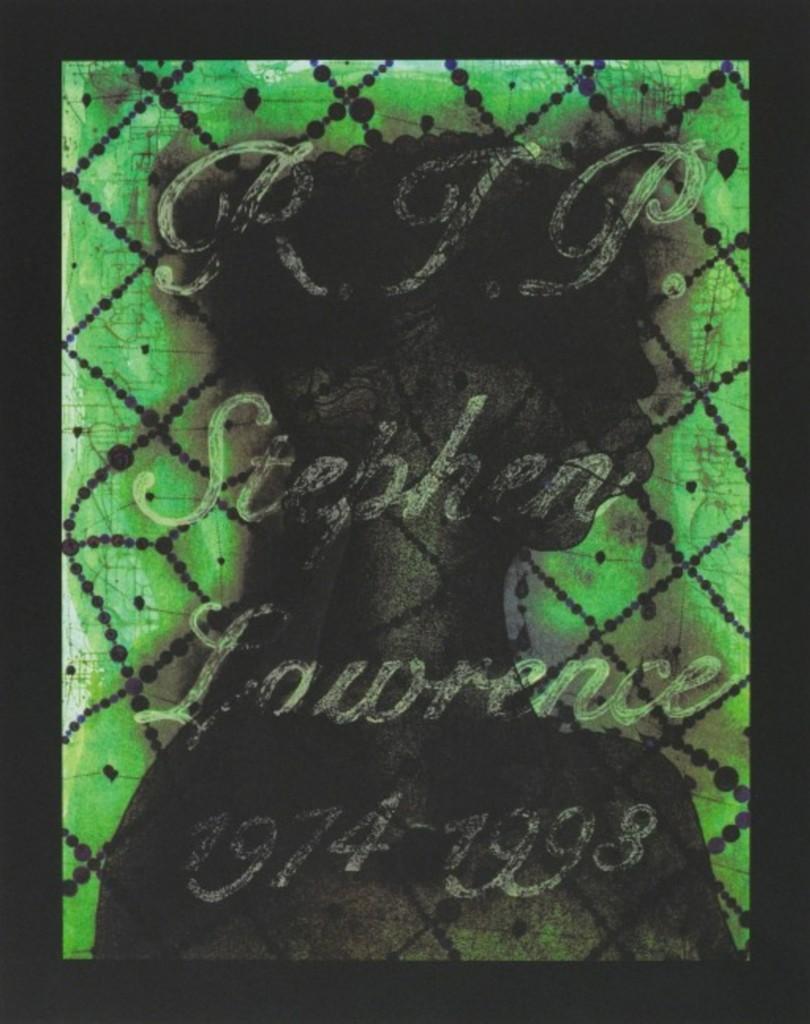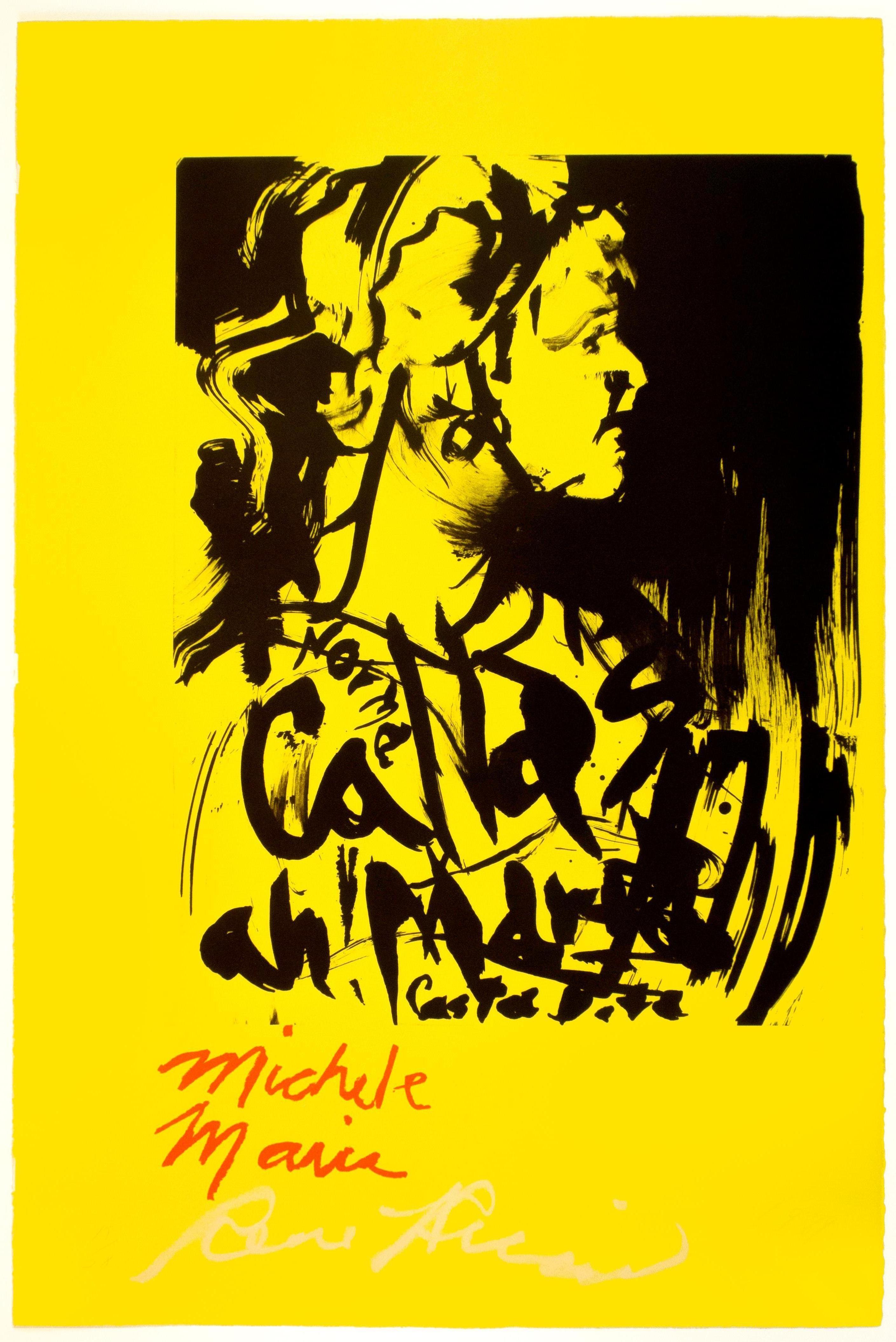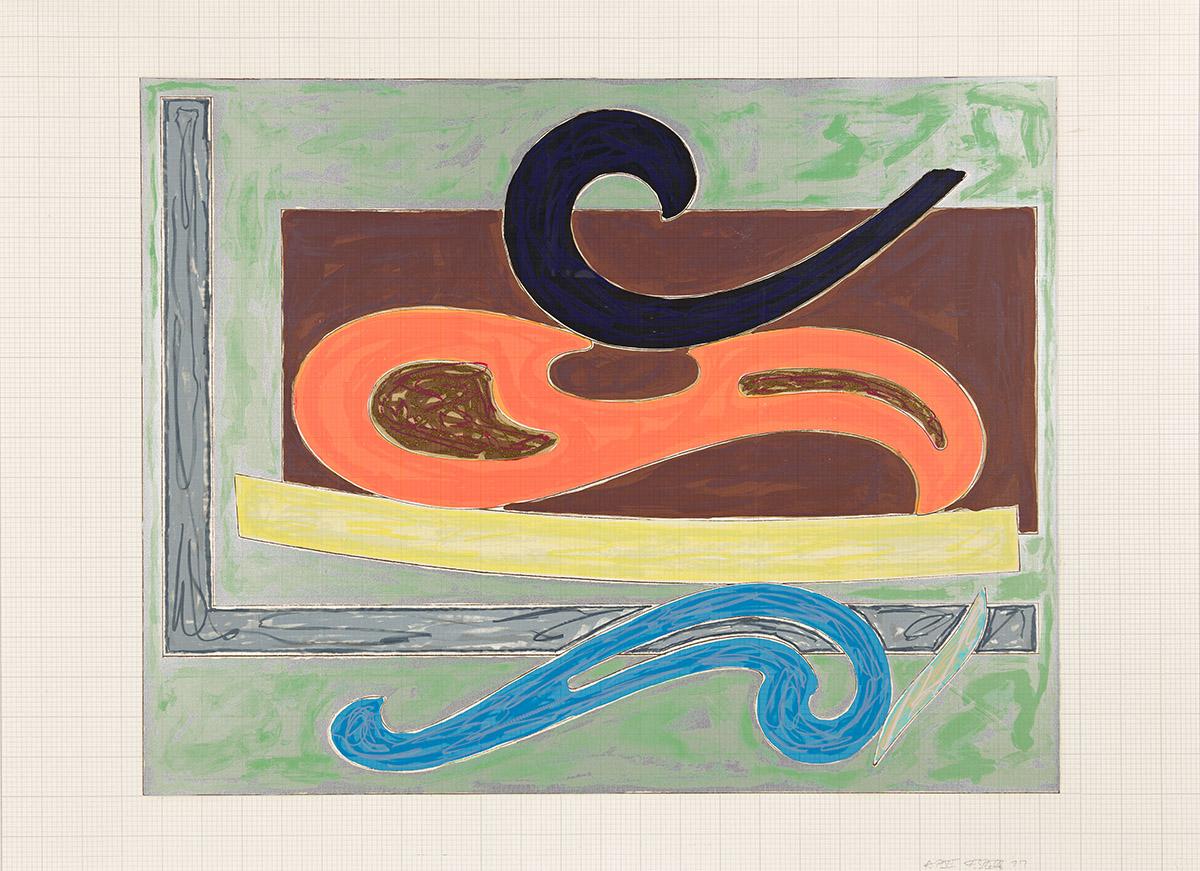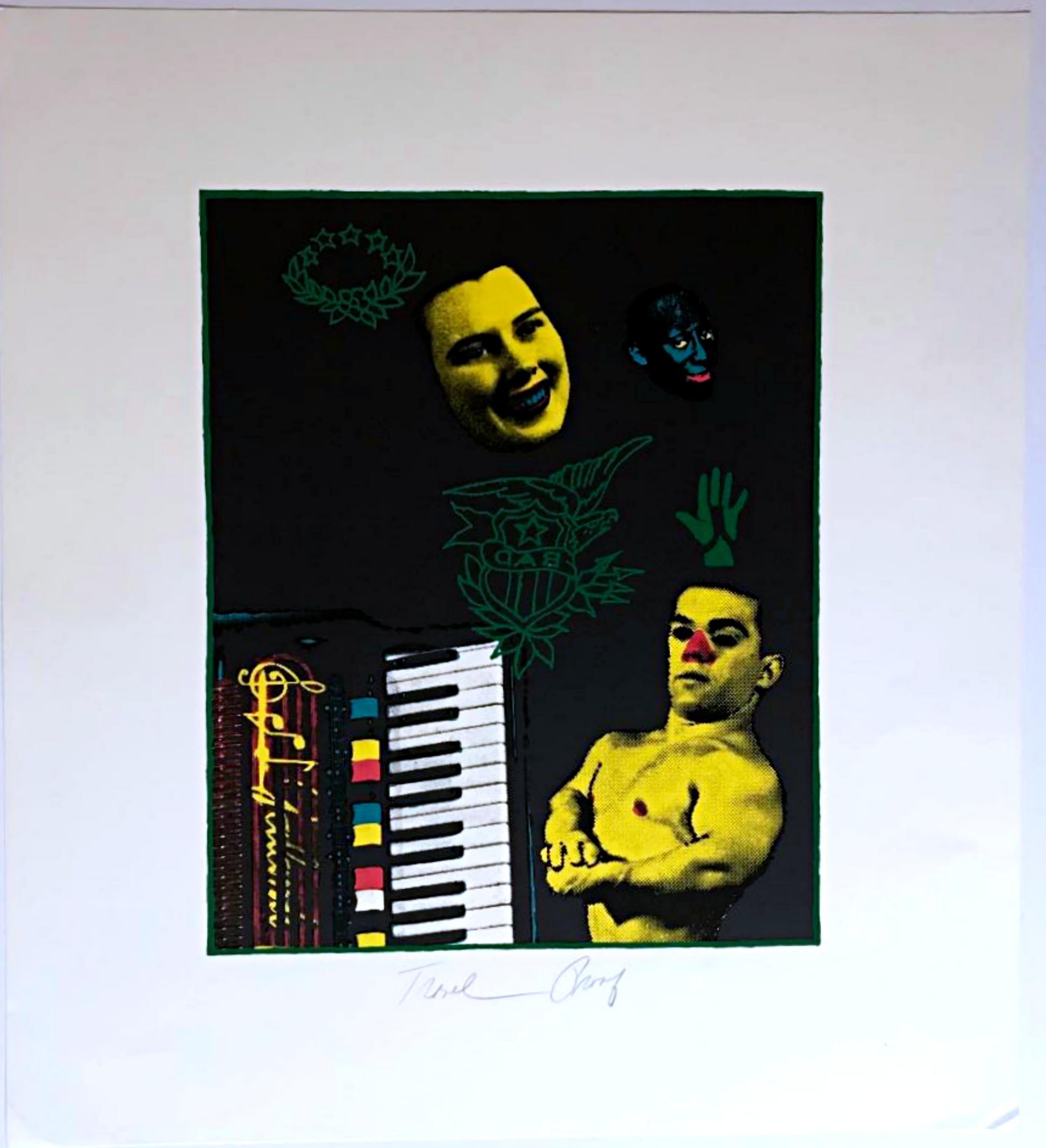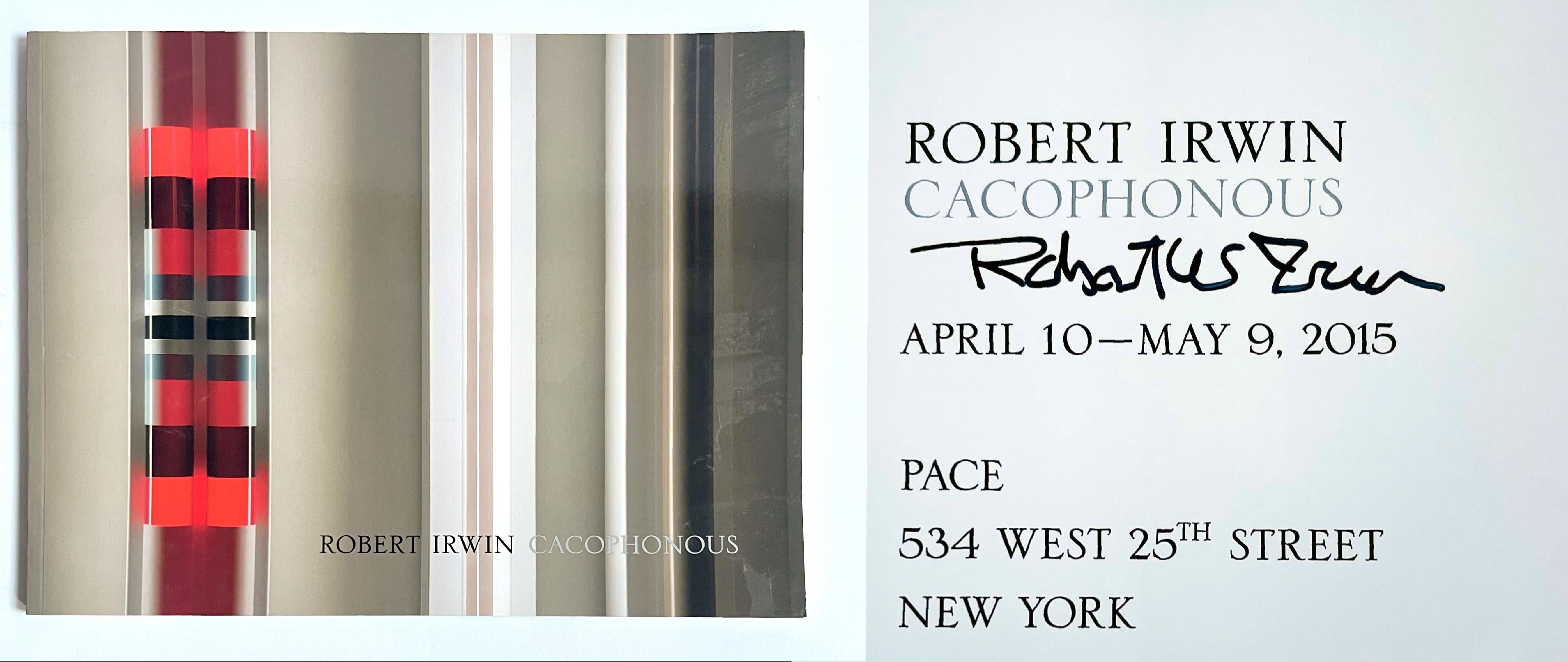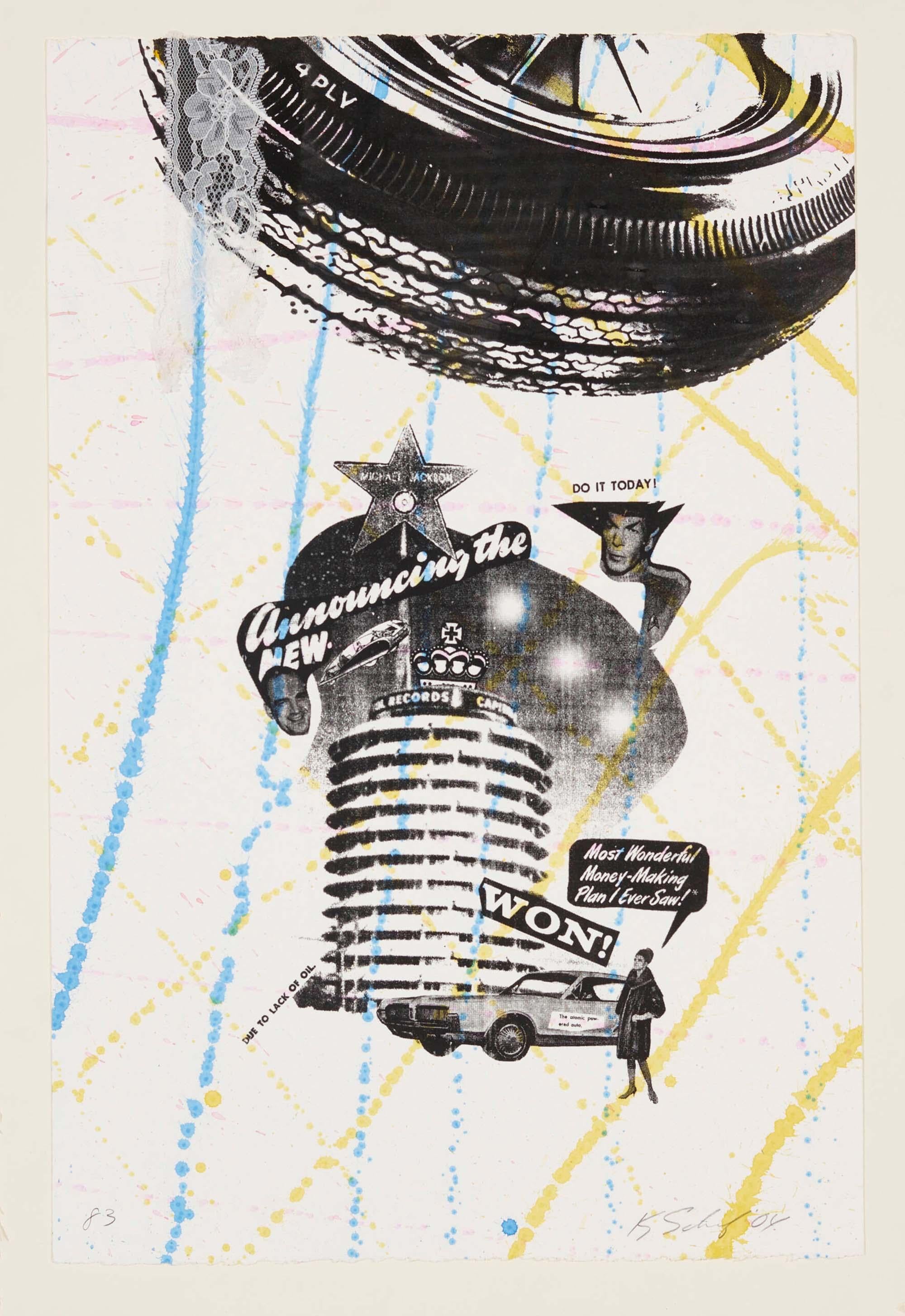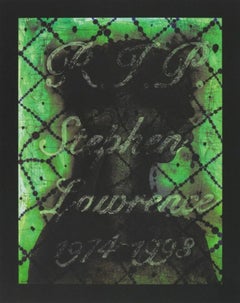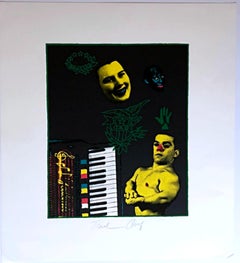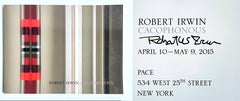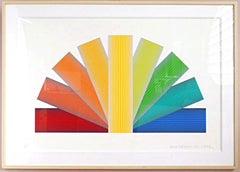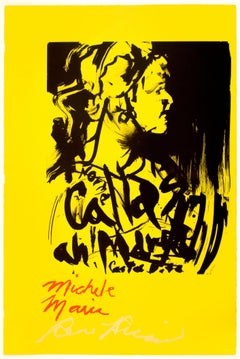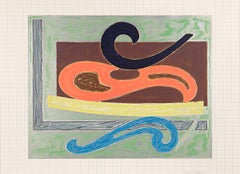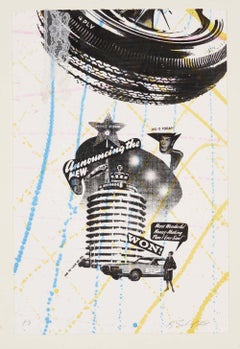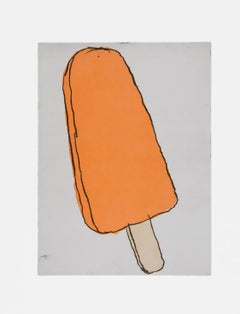Items Similar to Blankless Tone
Want more images or videos?
Request additional images or videos from the seller
1 of 10
Shusaku ArakawaBlankless Tone1979
1979
About the Item
Shusaku Arakawa
Blankless Tone, 1979
Color lithograph and silkscreen with embossing on Arches paper with deckled edges and folded collage upper left
Hand-signed by artist, Titled "Blankless Tone", signed "Arakawa", inscribed "1979 at New York City", and numbered 26/35, with publishers' blind stamp.
29 × 48 inches
Unframed
Dramatic light gold horizontal mixed media graphic work, pencil signed. numbered and inscribed, with text lettering and corner collage element. The Estate of Shusaku Arakawa is represented by Gagosian Gallery. This work is classic Arakawa - an important example of his way of displacing sometimes cryptic words onto images as a form of artistic philosophy and performance.
Shusaku Arakawa (荒川 修作 Arakawa Shūsaku, July 6, 1936 – May 18, 2010) who spoke of himself as an “eternal outsider” and “abstractionist of the distant future,” first studied mathematics and medicine at the University of Tokyo, and art at the Musashino Art University. He was a member of Tokyo’s Neo-Dadaism Organizers, a precursor to The Neo-Dada movement. Arakawa’s early works were first displayed in the infamous Yomiuri Independent Exhibition, a watershed event for postwar Japanese avant-garde art. Arakawa arrived in New York in 1961 with fourteen dollars in his pocket and a telephone number for Marcel Duchamp, whom he phoned from the airport and over time formed a close friendship. He started using diagrams within his paintings as philosophical propositions. Jean-Francois Lyotard has said of Arakawa’s work that it “makes us think through the eyes,” and Hans-Georg Gadamer has described it as transforming “the usual constancies of orientation into a strange, enticing game—a game of continually thinking out.” Quoting Paul Celan, Gadamer also wrote of the work: "There are songs to sing beyond the human." Arthur Danto has found Arakawa to be “the most philosophical of contemporary artists." For his part, Arakawa has declared: “Painting is only an exercise, never more than that.” Arakawa and Madeline Gins are co-founders of the Reversible Destiny Foundation, an organization dedicated to the use of architecture to extend the human lifespan. They have co-authored books, including Reversible Destiny, which is the catalogue of their Guggenheim exhibition, Architectural Body (University of Alabama Press, 2002) and Making Dying Illegal (New York: Roof Books, 2006).
Shusaku Arakawa was seven years old when the onset of World War II led his family to place him in a Buddhist monastery for two years to protect him. The conditions he endured there produced persistent nightmares, however, in the hope that his fears could be alleviated, he was sent to live with a neighborhood doctor and his wife for three years after the war. Arakawa became interested in medicine as a teenager and worked as the doctor's assistant while studying drawing, painting, and science in high school.
From 1954 to 1958 Arakawa studied medicine, mathematics and art in Japan and staged several "happenings". In 1960 he was affiliated with a Neo-Dada group in Tokyo and also participated in a demonstration against the continued existence of American military bases in Japan. To escape the controversy in which he then found himself embroiled, Arakawa moved to New York in 1961, where he met John Cage, Marcel Duchamp, and writer/philosopher Madeline Gins, whom he married.
Arakawa and Gins began to collaborate on a prodigious project called The Mechanism of Meaning, which melds physics, metaphysics, phenomenology and epistomology into a visual art form. A part of this series, approximately one-hundred panels, featuring images, texts, and objects, was first shown at the Venice Biennale in 1970. By this time Arakawa was also involved in filmmaking. He wrote and directed Why Not: A Serenade of Eschatological Ecology (1969), and collaborated with Gins on For Example (1971). Both films were shown at the Whitney Museum of American Art, New York.
Titled "Blankless Tone", signed "Arakawa", inscribed "1979 at New York City", and numbered 26/35, with publishers' blind stamp.
Excellent condition; the fold on the upper left is part of the collage design. The work was framed so there is some tape residue on the back
- Creator:Shusaku Arakawa (1936 - 2010, Japanese)
- Creation Year:1979
- Dimensions:Height: 29 in (73.66 cm)Width: 48 in (121.92 cm)
- Medium:
- Movement & Style:
- Period:
- Condition:Excellent condition; the fold on the upper left is part of the collage design. The work was framed so there is some tape residue on the back.
- Gallery Location:New York, NY
- Reference Number:1stDibs: LU1745212605512
About the Seller
5.0
Platinum Seller
Premium sellers with a 4.7+ rating and 24-hour response times
Established in 2007
1stDibs seller since 2022
430 sales on 1stDibs
Typical response time: 2 hours
- ShippingRetrieving quote...Shipping from: New York, NY
- Return Policy
Authenticity Guarantee
In the unlikely event there’s an issue with an item’s authenticity, contact us within 1 year for a full refund. DetailsMoney-Back Guarantee
If your item is not as described, is damaged in transit, or does not arrive, contact us within 7 days for a full refund. Details24-Hour Cancellation
You have a 24-hour grace period in which to reconsider your purchase, with no questions asked.Vetted Professional Sellers
Our world-class sellers must adhere to strict standards for service and quality, maintaining the integrity of our listings.Price-Match Guarantee
If you find that a seller listed the same item for a lower price elsewhere, we’ll match it.Trusted Global Delivery
Our best-in-class carrier network provides specialized shipping options worldwide, including custom delivery.More From This Seller
View AllR.I.P. Stephen Lawrence 1974-1993, UK racial violence victim, Silkscreen + Litho
By Chris Ofili
Located in New York, NY
Chris Ofili
R.I.P. Stephen Lawrence 1974 - 1993, 2013
Lithographic print in 4 colours with silkscreened glow-in-the-dark text
17 7/10 × 14 inches
Edition of 100
Accompanied by a numb...
Category
2010s Contemporary Portrait Prints
Materials
Lithograph, Screen
BAD (silkscreen and lithograph print) by renowned Chicago artist expressiionist
By Ed Paschke
Located in New York, NY
Ed Paschke
BAD, 1991
Silkscreen and Lithograph on Rising Mirage Paper, accompanied by documentation
Pencil signed, titled "BAD", and annotated "Trial Proof" on the front
22 × 20 inches
Unframed
Also accompanied by gallery issued Certificate of Guarantee
This work is a unique Trial Proof on Rising Mirage Paper, pencil signed by the artist and annotated "Trial Proof" the very first impression, aside from the regular edition. It is accompanied by the tirage sheet, with the biography of the artist and a description of the work. (see photos). As such it is a rare impression.
Published by Chicago Serigraphic Workshop and Artco, Incorporated
Ed Paschke Biography:
Ed Paschke was born in Chicago where he spent most of his life as an important painter. He was initially associated in the late 1960s with the second generation of Chicago Imagists who called themselves The Hairy Who. He received his B.F.A. from the School of The Art Institute of Chicago in 1961 and his M.F.A. in 1970. Between degrees he lived for a time in New York where he easily came under the influence of Pop art, in part, because of his interests as a child in animation and cartoons. His fascination with the print media of popular culture led to a portrait-based art of cultural icons. Paschke used the celebrity figure, real or imagined, as a vehicle for explorations of personal and public identity with social and political implications.
Although his style is representational, with a loose affiliation to Photorealism, Paschke’s art plays...
Category
1990s Contemporary Abstract Prints
Materials
Lithograph, Screen
Cacophonous PACE Gallery exhibition catalogue (hand signed by Robert Irwin)
By Robert Irwin
Located in New York, NY
Robert Irwin
Cacophonous (hand signed by Robert Irwin), 2015
Softback exhibition catalogue with stiff wraps (hand signed by Robert Irwin)
Hand signed by Robert Irwin on the title pag...
Category
2010s Contemporary More Art
Materials
Paper, Ink, Mixed Media, Lithograph, Offset, Screen
Grey tinted Rainbow, Geometric Abstract dazzling Op Art Framed assemblage Signed
By Richard Anuszkiewicz
Located in New York, NY
RICHARD ANUSZKIEWICZ
Grey Tinted Rainbow, 1992
Assemblage with 14 Color Silkscreen and Lithograph
Pencil signed and numbered 11/40 on the front
Frame included: elegantly framed in a ...
Category
1990s Op Art Abstract Prints
Materials
Mixed Media, Pencil, Lithograph, Screen
Guggenheim Museum Bilbao, silkscreen on aluminum, signed/N, Framed
By Richard Haas
Located in New York, NY
Incised signature in aluminum, annotated "Artists Proof" and titled; ink on top smudged
If you've ever visited the Guggenheim Bilbao, you should get this stunning mixed media on alum...
Category
Early 2000s Realist Figurative Prints
Materials
Metal
Untitled
By Harold Town
Located in New York, NY
Harold Town
Untitled, 1973
Silkscreen and Lithograph. Pencil Signed. Dated. Numbered.
Hand signed, dated and numbered by the artist on the front
39 1/4 × 27 1/2 inches
Unframed
Pencil signed and numbered from the limited edition of 55. De-accessioned from the Sears, Robuck & Co. art collection
Harold Town (1924-1990) has been dubbed the "Picasso of Canada" for his ever-changing aesthetic and perennial creativity, and he exhibited widely throughout Canada. He is best known as a founding member of the Painters Eleven, having coined the term for this artistic group himself. The name refers to the eleven Abstract Expressionist artists who banded together in Toronto between 1953 and 1960: Tom Hodgson, Jack Bush, William Ronald, Alexandra Luke, Oscar Cahén, Jock MacDonald, Ray Mead...
Category
1970s Abstract Abstract Prints
Materials
Lithograph, Screen
You May Also Like
Michele Maria: bright yellow red Maria Callas opera artist portrait with poetry
By Rene Ricard
Located in New York, NY
Touched by the influence of Andy Warhol, champion of a young Jean-Michel Basquiat, Rene Ricard served as enfant terrible of the 1980s New York art scene. In this bright yellow, red, ...
Category
1980s Contemporary Abstract Prints
Materials
Lithograph, Screen, Woodcut
Eskimo Curlew
By Frank Stella
Located in New York, NY
A very good impression of this color lithograph and screenprint on Arches 88 white wove paper. One of 14 numbered artist's proofs, aside from the edition of 50. Signed, dated, inscri...
Category
1970s Contemporary Abstract Prints
Materials
Color, Lithograph, Screen
Kenny Scharf mixed media 2004 (Kenny Scharf prints)
By Kenny Scharf
Located in NEW YORK, NY
Kenny Scharf 2004:
A rare mixed media piece by the legendary Los Angeles based artist. Hand-signed, dated and numbered by Scharf.
Medium: mixed media mono-print.
Dimensions: 22½ ...
Category
21st Century and Contemporary Contemporary Mixed Media
Materials
Mixed Media, Monoprint, Lithograph, Screen
Donald Baechler Creamsicle 1999 (Donald Baechler prints)
By Donald Baechler
Located in NEW YORK, NY
Donald Baechler, Creamsicle, 1999:
A fun, whimsical, and highly decorative signed limited edition Baechler piece that works well in any setting.
Medium: Soft-ground etching and aq...
Category
1990s Contemporary Abstract Prints
Materials
Etching, Aquatint, Lithograph, Screen
$1,800 Sale Price
20% Off
Donald Baechler Blue Muffin 1999 (Donald Baechler prints)
By Donald Baechler
Located in NEW YORK, NY
Donald Baechler, Blue Muffin, 1999:
A fun, whimsical, and highly decorative signed limited edition Baechler piece that works well in any setting.
Medium: Soft-ground etching and a...
Category
1990s Contemporary Abstract Prints
Materials
Etching, Aquatint, Lithograph, Screen
Donald Baechler Red + Blue Cup Cakes 1999 (Donald Baechler prints)
By Donald Baechler
Located in NEW YORK, NY
Donald Baechler, Red + Blue Cup Cakes, 1999:
A fun, whimsical, and highly decorative signed limited edition Baechler piece that works well in any setting.
Medium: Soft-ground etch...
Category
1990s Contemporary Abstract Prints
Materials
Etching, Aquatint, Lithograph, Screen
